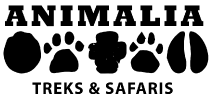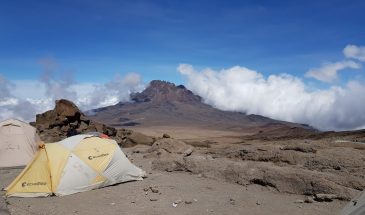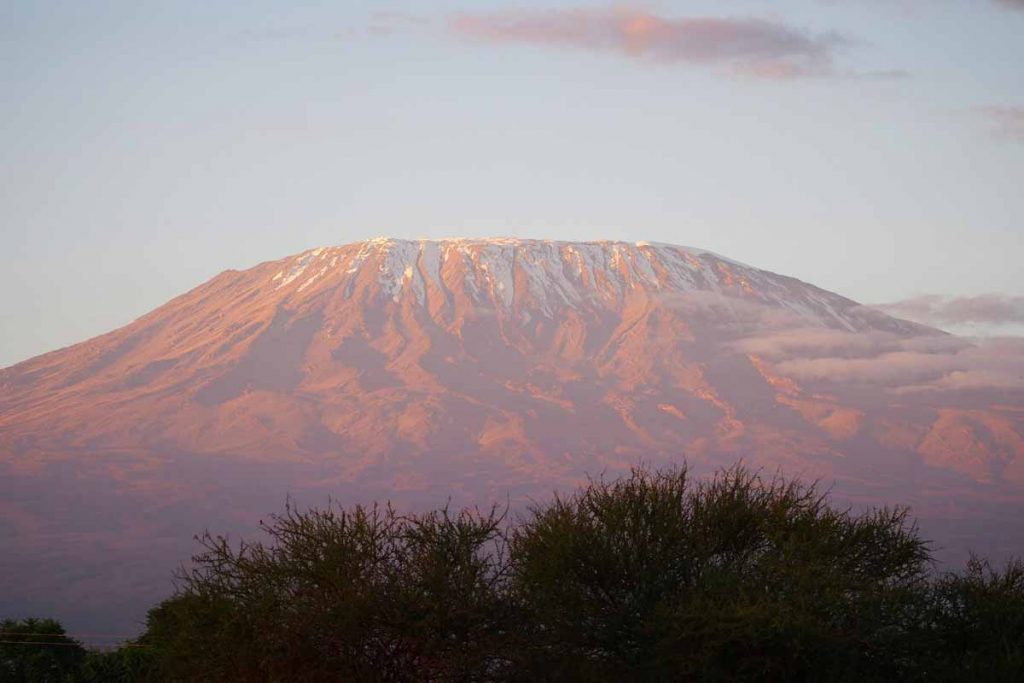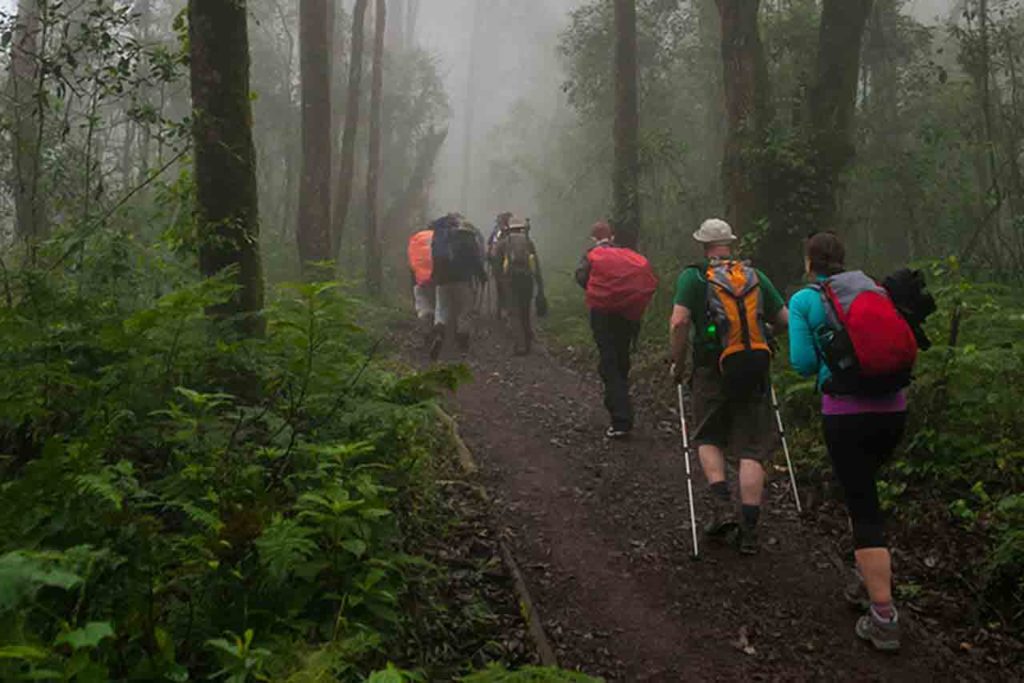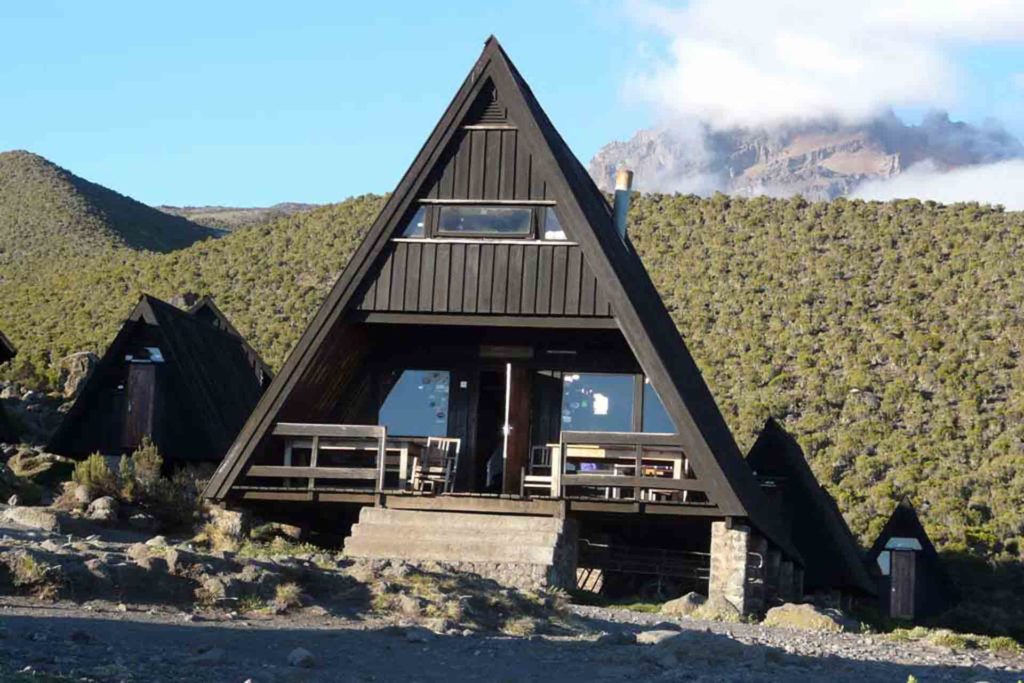- Overview
- Trip Outline
- Trip Includes
- Trip Excludes
- Gallery
- Booking
- FAQ
The Lemosho Route is a very beautiful and unspoilt route and sightings of wild game in the forest section is possible. The Lemosho route is one of the quieter routes up Kilimanjaro, this advantage however disappears when the route combines with the Machame route on the 3rd day of the hike. For those seeking a quiet route away from the crowds, the route is a superior option to the Rongai route. Unlike the Rongai the Lemosho route has the same excellent pro-acclimatization features of the Machame route, which it joins just before reaching Lava Tower.
We do not recommend hiking the Lemosho route during the rainy season as the start point of the Lemosho Route is particularly inaccessible during the wet season. Climbers should be prepared to walk the final 2-5 kilometers of the road following heavy rains. The journey time to reach the start point is quite long and joined to the possibility of not reaching the end of the road by vehicle head torches may well be needed to reach Forest Camp on day 1.
The route descents along the Mweka Route, a descent-only route.
The Lemosho Route is a very beautiful and unspoilt route and sightings of wild game in the forest section is possible. The Lemosho route is one of the quieter routes up Kilimanjaro, this advantage however disappears when the route combines with the Machame route on the 3rd day of the hike. For those seeking a quiet route away from the crowds, the route is a superior option to the Rongai route. Unlike the Rongai the Lemosho route has the same excellent pro-acclimatization features of the Machame route, which it joins just before reaching Lava Tower.
We do not recommend hiking the Lemosho route during the rainy season as the start point of the Lemosho Route is particularly inaccessible during the wet season. Climbers should be prepared to walk the final 2-5 kilometers of the road following heavy rains. The journey time to reach the start point is quite long and joined to the possibility of not reaching the end of the road by vehicle head torches may well be needed to reach Forest Camp on day 1.
The route descents along the Mweka Route, a descent-only route.
Itineraries
Arrival
Arrive in Tanzania
You will be picked up at the Kilimanjaro International Airport and transferred to your hotel in Moshi town; you will meet your guide who will brief you on your upcoming trek and do an equipment check to make sure you have all the necessary mountain gear. The missing gear can be rented on this day.
Overnight: at your Hotel in Moshi
Meals: Bed & Breakfast
Day 1
Lemosho Glades (2385m) to Big Tree Camp (2780m)
You will be picked up at your hotel at around 08:00am and transferred to the Lemosho gate located on the western side of Kilimanjaro. After the registration process you will still start our climb steadily through the forests of the Lemosho glades to reach Big Tree camp where you will be spending the night.
Distance: 7 km
Hiking Time: 3-4 hours
Meals: Lunch and Dinner Included.
Day 2
Big Tree Camp (2780m) to Shira 2 Camp (3900m)
Today you will cover a lot of ground as you trek across a plateau of grassy moorland and heather scattered with volcanic rock formations. We will trek through Shira 1 Camp from where there are often views of Kibo Peak floating on the clouds as we head towards our destination which is Shira 2.. We gain a reasonable amount of altitude as we head towards Shira 1 and parts of the route are fairly steep. As you proceed towards Shira 2 you will get the chance to view the Northern Ice fields from the western side of the mountain with some unusual views of Kibo. Our steady climb across the moorland of the Shira Plateau will help with acclimatization and we enjoy great panoramic views.
Distance: 16.5 km
Hiking Time: 9-11 hours
Meals: Breakfast, Lunch and Dinner Included.
Day 3
Shira 2 Camp (3900m) to Barranco Camp (3960m)
Our day starts by descending into the start of the Great Barranco, a huge ravine. We then exit steeply, up the Great Barranco Wall, which divides us from the southeastern slopes of Kibo. It’s a climb over rock, not technical but long and tiring. Passing underneath the Heim and Kersten glaciers, we head towards the Karanga valley. From here we have a steep climb up from Karanga valley to our night’s camp at Karanga camp, set at 3963m. For those feeling strong we will go for a mid-afternoon acclimatization trek up to around 4200m before descending back to camp for the night.
Distance: 5.5 km
Hiking Time: 5 hours
Meals: Breakfast, Lunch and Dinner Included.
Day 4
Barranco Camp (3960m) to Karanga Camp (3963m)
Our day starts by descending into the start of the Great Barranco, a huge ravine. We then exit steeply, up the Great Barranco Wall, which divides us from the southeastern slopes of Kibo. It’s a climb over rock, not technical but long and tiring. Passing underneath the Heim and Kersten glaciers, we head towards the Karanga valley. From here we have a steep climb up from Karanga valley to our night’s camp at Karanga camp, set at 3963m. For those feeling strong we will go for a mid-afternoon acclimatization trek up to around 4200m before descending back to camp for the night.
Distance: 5.5 km
Hiking Time: 5 hours
Meals: Breakfast, Lunch and Dinner Included.
Day 5
Karanga Camp (3963) to Barafu Camp (4640m)
After a good night’s rest and breakfast, we set off on our walk to Barafu camp at 4640m. The climb will take us across desolate scree slopes with no vegetation around us at all. It’s a tough steep walk made more difficult by the altitude. On arriving at camp we eat and spend the afternoon resting as we prepare for a long night and day ahead. It is important to keep hydrated and warm. We have an early dinner and then try to get some sleep as we will be getting up at between 11pm and 12pm to start the climb to the summit.
Distance: 3 km
Hiking Time: 3 hours
Meals: Breakfast, Lunch and Dinner Included.
Day 6
Barafu Camp (4640m) to Uhuru Peak (5895m) & down to Millennium Camp (3790m)
We start off at around midnight, and walk steeply upwards to the summit glaciers. We will be climbing scree for 4 to 5 hours but gain incredible height over a short distance. The views are spectacular. We should be on the crater rim at Stella Point (5739m) as the first rays of the sun hit us. Spectacular ice cliffs within the crater surround us and the views to jagged Mawenzi peak and beyond are breathtaking. Another hour’s walking takes us to the summit, Uhuru Peak (5895m). We begin our descent by returning to Stella Point and then descending on scree slope and track back to Barafu Camp for breakfast, before finally heading down to Millennium Camp for a long well-earned rest.
Distance: 13.5 km
Hiking Time: 12-15 hours
Meals: Breakfast, Lunch and Dinner Included.
Day 7
Trek Millennium Camp (3790m) to Mweka Gate (1630m)
A gentle trek takes us down through the rainforest to Mweka Gate, where we complete park formalities and receive certificates, which you can hang up with pride! We are then met by our vehicles and return to the hotel in Moshi, where you can treat yourself to a hot welcome shower.
Distance: 12.1 km
Hiking Time: 5-6 hours
Meals: Breakfast and Lunch Included.
Departure
Depart Tanzania
The day is left free to wind down after the trek before your flight home. Depending on flight times you could go and explore Moshi town and grab some gifts shop before heading to the airport.
- Private transport to & from Kilimanjaro International Airport to your accommodations in Moshi.
- Transportation to & from the Kilimanjaro gate.
- Park entry fees,
- Camping fees.
- Team Kilimanjaro Rescue fees.
- Friendly and professional mountain guides, cook, and porters.
- Accommodations
- Professional Mountain guide
- Enough treated & filtered drinking water throughout the trek.
- Hot water for washing.
- Government taxes.
- Emergency first-aid kit
- 18% VAT on tour fees & services.
- Mountain tents.
- All meals on the mountain (breakfast, lunch & dinner)
- Fair wages for the mountain crew as approved by the Kilimanjaro National Park Authority (KINAPA), and the Kilimanjaro Association of Tour Operators (KIATO).
- Meals and drinks not specified
- Mountain equipment (eg sleeping bags)
- Gear for your climb, Some equipment is available for rent!
- Items of personal nature (expenses)
- Emergency Oxygen
- Additional nights beyond the two standard hotel nights included
- Extra activities (waterfall tour, cultural village visit).
- Visa fees & travel insurance.
- Flight tickets.
- Tips for guides, porters, and cooks (this is a guide to tipping on the mountain http://www.kiliporters.org/tipping_recommendations.php
The best time to climb Kilimanjaro is during the dry season, i.e., from June to early November and from December to end of March. However with changing weather patterns, the chances of getting a clear sky during your climb in November and April is rare.
Yes we do have a kit list of all the items you will require for your climb. You can rent sleeping bags, parkas, gaiters, trekking poles, etc. Just e-mail us your list of needs, and we will reserve these items for provide you upon your arrival.
Anybody who are able to run for at least half an hour without feeling shortness of breath. You should also be able to walk for at least 2 hours in hilly terrains without feeling overly exhausted. No one with a sore throat, cold of breathing problems should go beyond 3000m. However, anybody with heart or lung problems should consult his/her physician before attempting to climb Mt Kilimanjaro.
No, you are not required to bring filtering systems or purification tablets, our climbing staff will provide you with plenty of purified drinking water during your trek.
The climb to Kilimanjaro is not a technical climb. No mountaineering equipment is require to summit Kilimanjaro. Anyone in good physical condition can reach the top of Mount Kilimanjaro.
Yes. The price also contains the salary of a porter, who is assigned to carry the oxygen tanks during your summit attempt.
Our mountain crews are in constant radio communication with us via ICOM radios so if anything goes wrong on your trekking we are informed. Also, the cell reception on the mountain has improved so we can effectively communicate with our teams using mobile phones.
The symptoms of altitude sickness can appear while climbing Mt. Kilimanjaro, in all climbers irrespective of their age and/or fitness level. Due to which, most climbers choose to use Diamox (Acetazolamide), a medication that diminishes headache, tiredness, nausea, dizziness, and shortness of breath which occur when climbing to high altitudes. Side effects include a tingling sensation in fingertips and on the face, and frequent urination.

